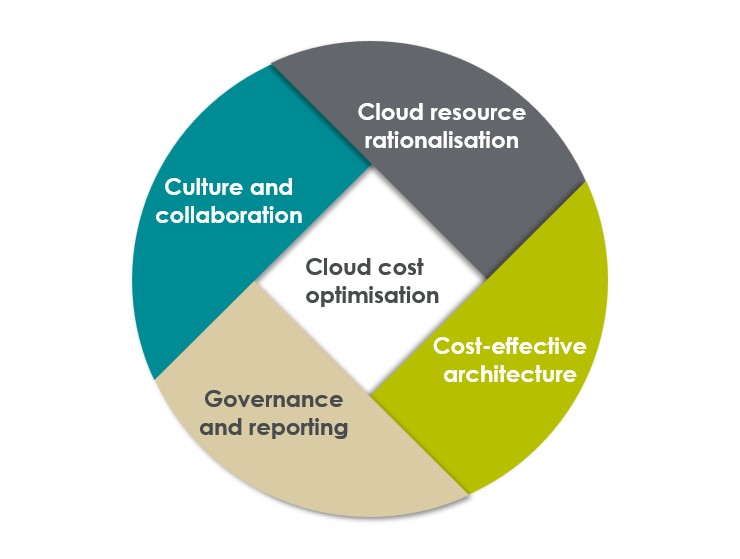Demystifying cloud spending: How to optimise your cloud costs

key fact
Gartner predicts, by 2026, the proportion of organisations performing real-time cost or performance optimisation of cloud-based workloads will increase from less than 20% in 2022 to 50%.
Organisations can be drawn to the cloud for several reasons, such as organic growth, expiring data centre support, a strategic push for greater flexibility and scalability, or simply to streamline operations.
No matter the reason, more and more organisations are moving their workloads to the cloud. This shift has led to a significant increase in recurring cloud costs. Many are struggling to manage these expenses, often resulting in uncontrolled monthly bills from the major cloud providers, known as Hyperscalers.
According to the Flexera’s 2024 state of the cloud report, optimising existing cloud use for cost savings has been the top initiative for eight consecutive years, rising from 62% to 71% year-on-year.
Challenges
Obstacles in achieving cost-effective solutions
With over 200 services from Amazon Web Services and Azure, and over 100 from Google Cloud Platform, it is no wonder many organisations struggle to find the most cost-effective option. Different ways of designing and deploying the same application can lead to widely varying costs.
Complex and layered pricing across Hyperscalers
Each service on your bill charges differently. For example, with Amazon Simple Storage Service, some fees are per request, others per gigabyte. This makes understanding your cloud bill tricky and overwhelming, as there is so much data to process and grasp the overall picture.
Easy setup and unexpected costs from cloud sprawl
With just a click of a button, cloud consumers can quickly spin up an environment. Without limits on resource allocation, this can lead to cloud sprawl and, inevitably, unexpected costs.
Unable to detect cloud cost anomalies early
Without proper monitoring and alerting, cloud cost anomalies are often identified too late or missed entirely.
Lack of billing standardisation among Hyperscalers
In multi-cloud environments, non-standardised billing complicates getting a unified overview. Diverse commitment terms across Hyperscalers, different savings schemes, cost metrics, and various tagging conventions make managing multiple cloud platforms a challenge. As a result, accurately attributing costs becomes nearly impossible.
A common misconception is that migrating IT to the cloud will automatically lower costs.
Approach
Finding the right balance between cost-efficiency and innovation, without friction, is crucial for success in today’s ever-changing technical environment. Cloud cost management requires continuous refinement through both strategic and tactical approaches. For example, regularly auditing cloud usage and rightsizing instances can reduce unnecessary expense while still enabling investment in cutting-edge technologies. Similarly, implementing governance guardrails and embedding cost management into architectural practices can ensure financial discipline while fostering innovation.
Figure 1 – Cloud cost optimisation
Culture and collaboration
Unlike on-premises, where expenditure is typically a one-time purchase of a specific fixed asset within a single financial year, managing costs in the cloud requires ongoing cross-functional collaboration between IT finance, application developers, and IT infrastructure and operations (I&O). Executive leaders also need to support this effort.
Consider a more decentralised approach for managing cloud resources by letting the teams who use them handle their own budgets. Make sure there’s a clear process for approving these budgets and keep track of how much is being spent.
Cloud resource rationalisation
When it comes to cloud resources, it is easy for things to get out of hand, leading to a build-up of unused items over time. By identifying and clearing out these unused resources, you can eliminate waste.
It is important to regularly monitor resources to make sure they are correctly allocated for their workload as demands change. Cutting down on over- provisioned resources can lead to significant cost savings. One effective way to optimise costs is by implementing autoscaling, which adjusts resources based on usage.
Hyperscalers offer a range of flexible packaging and pricing options, making their services complex and always evolving. Understanding actual resource utilisation is key to developing an effective cost model. For example, you can use reserved instances for predictable workloads, commit to usage for a 1- or 3-year term, or opt for preemptible instances for non-critical workloads.
Choosing the right storage service and tier is also crucial for cost-effectiveness. Proper storage tiering and data lifecycle management can help reduce costs, such as using cold storage for data that is not accessed frequently.
Cost-effective architecture
Adopting a well-architected framework is key to achieving cost efficiency, operational excellence, scalability, and optimal performance.
Depending on your in-house capabilities, it is important to weigh the benefits of platform services, which offer managed environments for easier deployment, versus containerisation, which provides flexibility and portability. Consider how each option aligns with your long-term strategy. If flexibility and portability are important, containerisation might be more beneficial. On the other hand, if ease of use and reduced operational burden are your priorities, platform services could be the better choice.
With each update, Hyperscalers release new instance types from their latest platforms, organised into a new ‘generation’. These are designed to fulfil the same needs as their predecessors but with enhanced power. As part of your ongoing right-sizing efforts, consider using newer generation instances to boost performance and cut costs.
Governance and reporting
It is essential to establish clear policies for managing resource utilisation, tagging, and the decommissioning of unused resources. Make sure you have enforcement measures in place so that resources are not provisioned without proper tagging and adherence to guidelines.
To manage costs effectively and increase awareness of cloud spending, it is crucial to establish key tracking metrics, such as actual versus forecasted spending and the percentage of overall expenditure. This approach helps you identify spending trends, detect significant changes or anomalies, and uncover any potential waste.
A one-off removal of waste will not be cost-effective. This needs to be an ongoing activity involving all stakeholders. Cloud optimisation is possible, but each organisation’s setup and evolution are different. Here at Mason Advisory, we can adapt, and tailor solutions based on your specific requirements.
If you would like to speak to Shaheen Ansari regarding this insight, send your enquiry to contact@masonadvisory.com.
To find out more about our services, click here.
